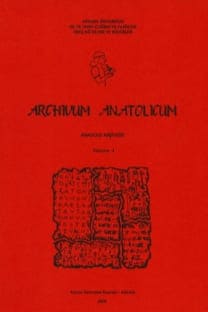Eski Asurca Kaynaklara Göre Asur-Anadolu İlişkilerinde Hahhum Krallığı’nın Önemi
Kültepe, Hahhum, Çiviyazısı
The Importance of Hahhum Kingdom in the Relationships Between Assur and Anatolia According to the Old Assyrian Sources
___
- Astour, Michael Czernichov. “Overland Trade Roads in Ancient Western Asia” içinde Civilizations of the Ancient Near East, ed. Jack M. Sasson, 1409. New York: Simon & Schuster, 1995.
- Barjamovic, Gojko. A Historical Geography of Anatolia in the Old Assyrian Period. Copenhagen: Museum Tusculanum Press, 2011.
- Çeçen, Salih ve Hecker Karl. “ina mātika eblum. Zu einem neuen Text zum Wegerecht,” içinde, Festschrift Für Wolfram Freiherm von Soden zum 85,Geburtstag am 19.Juni 1993, ed. Manfried Dietrich ve Oswald Loretz (Münster: Neukirchener Verlag,, 1993)
- Edzard, Dietz Otto. Gudea And His Dynasty, The Royal Inscriptions of Mesopotamia Early Periods, Volume 3/1. Toronto: University of Toronto Press, 1997.
- Günbattı, Cahit. “Kültepeden Akadlı Sargon’a ait Bir Tablet” Archivum Anatolicum 3 (1997) 146.
- Günbattı, Cahit. “Kültepe’den Bulunmuş İki Antlaşma Metni,” Belleten c.LXIX, 69 (Aralık 2005): 773.
- Günbattı, Cahit. Kültepe Kaniş Anadolu’da İlk Yazı İlk Belgeler, Kayseri: Kayseri Büyükşehir Belediyesi Kültür Yayınları 2017.
- Liverani, Mario. “The Fire of Hahhum” Orient Antiquus (OrAnt) 27, (1988) 165-172.
- Nashef, Khaled. Die Orts-und Gewässernamen der altassyrischen Zeit, (RGTC IV), Dr. Ludwig Reichert Verlag, Wiesbaden 1991. Orlin, Louis Lawrence. Assyrian Colonies in Cappadocia. Paris: Printed in the Nederlands by Mouton - Co.,Printers Hague, 1970.
- Özgüç, Nimet. Samsat. Ankara: Türk Tarih Kurumu Yayınları, 2009.
- Smith, Sidney, Cuneiform Texts from Cappadocian Tablets in the British Museum Part IV. London: British Museum, 1927.
- ISSN: 1300-6355
- Yayın Aralığı: Yılda 2 Sayı
- Başlangıç: 1995
- Yayıncı: Ankara Üniversitesi
Soranus’ Text “On Signs of Fractures”
Yeni Asur Emperyalizminin Bir Sonucu Olarak İsyanlar
Asur Ticaret Kolonileri Dönemi'nde Nafaka Ödeniyor muydu?
Eski Asurca Kaynaklara Göre Asur-Anadolu İlişkilerinde Hahhum Krallığı’nın Önemi
Eski Asurca Metinlerde Anadolu Köprüleri
Zu den Rezenten Studien im Hattischen: Eine Zwischenbilanz
